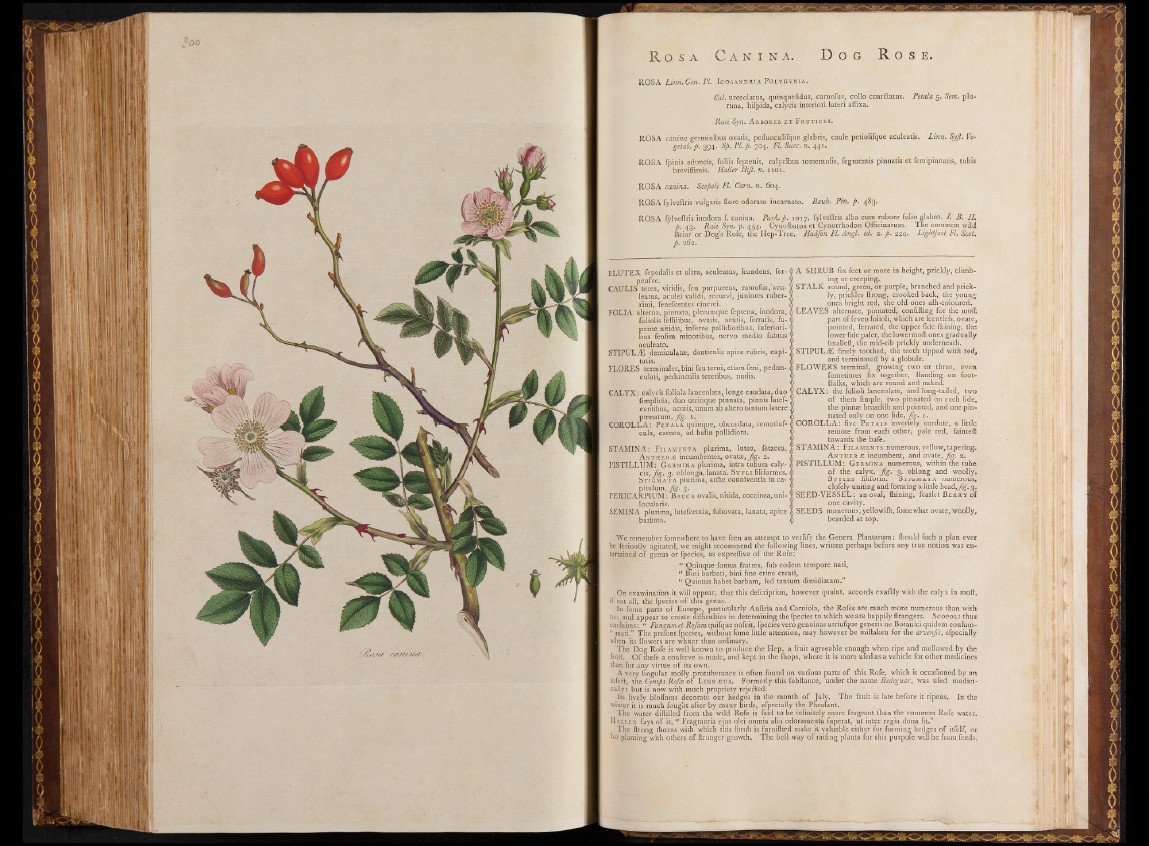
R osa C a n i n a. D o g R o s e
ROSA Linn.Gen.Pl. Icosandria Po lygyn ia .
Cal. urceolatus, quinquefidus, carnofus, collo coar&atus. Petala 5. Sem. plurima,
hifpida, calycis interiori lateri affixa.
Rail Syn. A rbores et Frutices.
ROSA canina germinibus ovatis, pedunculifque glabris, caule petiolifque aculeatis. Linn. Syfi. Ve-
getab. p. 394. Sp. PI. p. 704. FI. Suec. n. 441.
ROSA fpinis aduncis, foliis feptenis, calycibus tomentofis, fegmentis pinnatis et femipinnatis, tubis
breviffimis. Haller Hiß. n. 1101.
ROSA canina. Scopali FI. Cam. n. 604.
ROSA fylveftris vulgaris flore odorato incarnato. Bank. Pin. p. 483.
ROSA fylveftris inodora f. canina. Park.p. 1017. fylveftris alba cum rubore folio glabro. I. B. II.
p. 43. Raii Syn. p. 454. Cynofbatos et Cynorrhodon Officinarum. The common wild
Briar or Dog’s Rofe, the Hep-Tree. Hudfon Fl. Angl. ed. 2. p. 220. Lightfoot FI. Scot,
p. 262. *
•ELUTEX fepedalis et ultra, aculeatus, fcandens, fer-
l penfve.
CAULIS teres, viridis, feu purpureus, ramofus,'acu- |
leatus, aculei validi, recurvi, juniores ruber- (
rimi, fenefcentes cinerei.
FOLIA alterna, pinnata, plerumque feptena, inodora,
foliolis ieffilibus, ovatis, acutis, ferratis, fu-
perne nitidis, inferne pallidibribus, inferiori-
bus fenfim minoribüs, nervo medio fubtus
aculeato.
STIPULÆ denticulatae, denticulis apice rubris, capi-
tatis.
FLORES terminales, bini feu terni, etiam feni, pedun-
culati, pedunculis teretibus, nudis.
CALYX: calycis foliola Ianceolata, longe caudata, duo
fimplicia, duo utrinque pinnata, pinnis latef-
centibus, acutis, unum ab altero tantum latere
pinnatum, fig. 1.
COROLLA: Petala quinque,. obcordata, remotiuf-
cula, carnea, ad bafin pallidiora.
STAMINA: Filament a plurima, lutea, fetacea.
A ntheræ incumbentes, ovatat,fig. 2.
PISTILLUM: G ermina plurima, intra tubum calycis,
fig. 3. oblonga, lanata. St y l i filiformes.
Stigmata plurima, ar£te conniventia in ca-
pitulum, fig. 3.
PERICARPIUM: B acca ovalis, nitida, coccinea, uni-
locularis.
SEMINA plurima, lutefcentia, fubovata, lanata, apice
barbata.
) A SHRUB fix feet or more in height, prickly, climb-
> ing or creeping.
1 STA LK round, green, or purple, branched and prickly,
prickles ftrong, crooked back, the young
ones bright red, the old ones afh-coloured.
1 LEAVES alternate, pinnated, confifting for the moll
part o f feven folioli, which are fcentlefs, ovate,
pointed, ferrated, the upper fide Ihining, the
lower fide paler, the lowermoft-ones gradually
fmalleft, the mid-rib prickly underneath.
| ST IPU LE finely toothed, the teeth tipped with red,
and terminated by a globule.
) FLOWERS terminal, growing two or three, even
fometimes. fix together, ftanding on foot-
ftalks, which are round and naked.
• C A L YX : the folioli lanceolate, and long-tailed, two
of them fimple, two pinnated on each fide,
the pinnae broadifti and pointed, and one pinnated
only on one fide, fig. 1.
) COROLLA: five Petals inverfely cordate, a little
remote from each other, pale red, fainteft
towards the bafe.
* STAMINA: Filaments numerous,yellow,tapering.
A ntherm incumbent, and ovate, fig. 2.
') PISTILLUM; G ermina numerous, within the tube
of the calyx, fig. 3. oblong and woolly.
S tyles filiform. Stigm a ta numerous,
clofely uniting and forming a little head,fig. 3,
| SEED-VESSEL: an oval, Aiming, fcarlet Berry of
one cavity.
[ SEEDS numerous, yellowilh, fomewhat ovate, woolly,
bearded at top.
We remember fomewhere to have feen an attempt to verfify the Genera Plantarum: ftiould ftich a plan ever
be ferioufly agitated, we might recommend the following lines, written perhaps before any true notion was entertained
of genus or fpecies, as expreflive of the Rofe;
• “ 'Quinque fumus fratres, fub eodem tempore nati,
** Bini barbati, bini fine crine creati,
“ Quintus habet barbam, fed tantum dimidiatam.”
On examination it will appear, that this defcription, however quaint, accords exa&ly with the calyx in moft,
if not all, the fpecies of this genus.
In fome parts of Europe, particularly Auftria and Carniola, the Rofes are much more numerous than with
us; and appear to create difficulties in determining the fpecies to which we are happily ftrangers. Scopoli thus
exclaims: (( Fungum et Rofam quifque nofcit, fpecies vero genuinas utriufque generis ne Botanici quidem confum-
“ mati.” The prefent fpecies, without fome little attention, may however be miftaken for the arvenfis, efpecially
when its flowers are whiter than ordinary.
The Dog Rofe is well known to produce the Hep, a fruit agreeable enough when ripe and mellowed by the
frolt. Of thefe a conferve is made, and kept in the (hops, where it is more ufed as a vehicle for other medicines
than for,any virtue of its own.
A very lingular mofl’y protuberance is often found on various parts of this Rofe, which is occafioned by an
infe61, the Cynips Rofce of L inn.«us. Formerly-this fubftance, under the name Bedeguar, was ufed medici-
ually; but is now with much propriety reje&ed.
Its lively bloflbms decorate our hedges in the month of July. The fruit is late before it ripens. In the
winter it is much fought after by many birds, efpecially the Pfieafant.
The water diftilled from the wild Rofe is faid to be infinitely more fragrant than the common Rofe water.
Haller fays of it, " Fragrantia ejus olei omnia alia odoramenta fuperat, ut inter regia dona fit.”
The ftrGng thorns with which this flirub is furnifhed make it valuable either for forming hedges of itfelf, or
for planting with others of ftronger growth. The bell way of raifing plants for this purpofe will be from feeds,